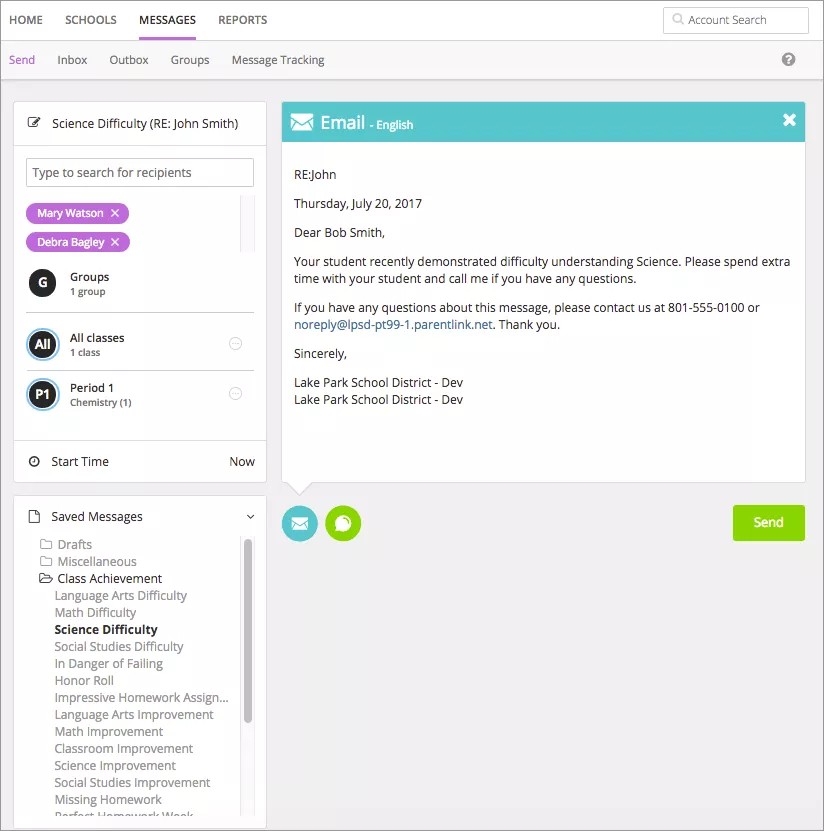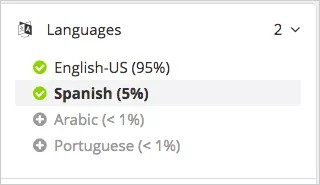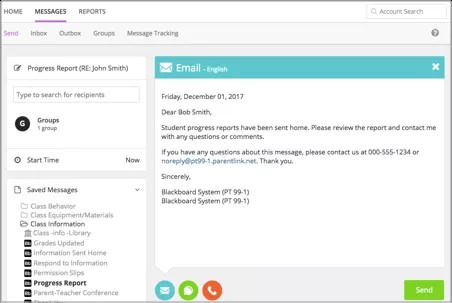Communicate effectively.
Your school's website includes a simple-to-use notification system that is designed for teachers — Teacher Communications. You can send messages to any of your students, the entire class, all your classes, or just to parents. Plus, Teacher Communications allows you to send pre-made messages. These messages are categorized into teacher specific categories and can be targeted to select students based on the message subject. You can also create your own message.
Check it out!
Send my own message
If you want to create your own message instead of sending a pre-made message, you can type your own content in Send Message page. You can then select to send it as an email, text/SMS message, or if set by your school, as a phone message.
- Select Messages.
Each teacher's students are separated into classes.
- Select the class or a user group.
Is there a group of students or parents that you contact on a regular basis? Create a special user group!
- To send a message to one or a few members, select the specific users. You can select all parents or all students, or use the list icon to select individual users. You can also search for specific users by name.
- Type the Subject.
- Select one or more delivery methods from the main send message page to send to the recipients:
- Emails - Type your text and add any images. To remove the email option, close out the tab from the upper right hand corner.
- Text/SMS - Content needs to be less than 160 characters. To copy content from the email message, select the Copy Content icon. To remove the text/SMS option, close out the tab from the upper right hand corner.
- Select Start Time to change the time to send the message. If you want to repeat message, you can also add more dates and times. You cannot send messages during your school's blackout times.
- Include language translations by selectingLanguage, and select each language needed.
You can remove any language with the Delete icon.
Amheric language will not include translation or text-to-speech capabilities. Some Android devices and iOS do NOT support Amheric, and the message may not look correct on those devices. However, it is expected that those users requiring Amheric language will use phones that support the display.
If needed, check the text message option if over the character limit.
- Select Send when finished.
Send a pre-made message
Pre-made messages allow you to quickly send standard, student-type messages to students in your classes or specific user groups you created. There are several you can choose from.
- System created: Written and recorded in four supported languages: English, Spanish, Portuguese, and Haitian-Creole. Can't be edited, copied, or deleted. Identified by the Blackboard logo.
- Admin created: Created by your district administrator. Can be copied only. Identified by an image of a building.
- User created: Written and recorded by a user. Can be edited, copied, and deleted. Identified by an image of a person.
All of the system pre-made teacher messages are available in several languages including English, Spanish, French, German, Mandarin, and Cantonese. Any of these messages will send in the preferred language of the recipient if available.
Messages will deliver at the optimal start time set by the school or district, and will also adhere to the school or district call window. Contact the school administrator about the teacher message delivery times at each school.
-
Select Messages.
Each teacher's students are separated into classes.
- Select the class or a user group.
- To send a message to one or a few members, select the specific users. You can select all parents or all students, or use the list icon to select individual users. You can also search for specific users by name.
- Select a message category from the Saved Messages list.
Category examples may include Class Achievements, Class Behavior, or Class Projects.
- Select the messages to use. The message will appear in the Send Message page.
- Type the Subject.
- Select one or more delivery methods from the main send message page to send to the recipients:
- Emails - You can update the text and add any images. To remove the email option, close out the tab from the upper right hand corner.
- Text/SMS - Content needs to be less than 160 characters. To remove the text/SMS option, close out the tab from the upper right hand corner.
- Select Send when finished.
What if I want to send a phone message?
By default, teachers cannot send phone messages unless the feature has been turned on by your district. If it is available, a phone icon will be available on the Send Message page. You can record audio to attach to your message. You can use your school's phone system to record the message, upload an audio file you created, or type text that will translate to speech. You select your recording option from the Phone list when creating a new message.
- If you select Call me to record, type your phone number and select Call me to record.
- If you select Call In to record, follow the on-screen instructions to record the message.
- Call the number listed.
- Immediately enter the unique four-digit code.
- Record the message after the prompt.
- Press pound # when finished.
- Select from the menu options:
- Press 1 to save the message.
- Press 2 to listen to the message.
- Press 3 to re-record the message.
- When satisfied with the message, press 1 and wait for the confirmation message before hanging up.
- If you select Upload Audio file, select Browse to find and upload your recorded audio file.
- If you select Text to Speech, type your message in the Text messages box. Select Play Audio to listen to the message, or type your phone number and select Call to hear your message.
Create accessible messages
Creu Negeseuon Hygyrch
A wyddoch chi fod gan biliwn o bobl yn y byd anabledd meddyliol neu gorfforol? Neu fod gan 12.9% o holl fyfyrwyr Gogledd America rhyw fath o anabledd? Mae'n bwysig sicrhau bod pob un o'ch myfyrwyr ac aelodau o'r gymuned yn deall eich cyfathrebiadau.
Arferion gorau o ran hygyrchedd wrth gyfathrebu
Does dim ots os ydych chi'n defnyddio e-bost neu Facebook, mae gwneud eich negeseuon yn hygyrch yn hawdd gyda'r arferion hygyrchedd gorau hyn.
- Ysgrifennwch yn glir. Cadwch eich brawddegau'n fyr. Defnyddiwch eiriau, neu gyfuniad o eiriau, gyda 1-2 sillaf ble fo'n bosib. Defnyddiwch gywasgiadau. Defnyddiwch offer megis Hemmingway Editor i fesur darllenadwyedd eich testun.
- Peidiwch â defnyddio gwahanol ffontiau neu liwiau yn unig i ddynodi pwysigrwydd! Pan fo angen ichi roi awgrym gweledol cryf, gwnewch yn siŵr eich bod yn defnyddio dull hygyrch amgen. Defnyddiwch ebychnod ar ddiwedd eich brawddeg os ydyw'n bwysig. Mae darllenwyr sgrîn yn llafarganu ebychnodau a gofynodau. Nid yw hyn yn golygu y bydd yr offeryn yn darllen "ebychnod" yn uchel—yn hytrach, bydd yn defnyddio tôn holgar wrth ddarllen y cwestiwn yn uchel.
- Dylech gynnwys testun amgen yn eich delweddau. Does dim angen i chi ddweud "Delwedd o" gan fod yr offer cynorthwyol eisoes yn gwybod mai delwedd ydyw. Byddwch yn gryno, yn glir ac yn ddisgrifiadol. Peidiwch â defnyddio'r un testun amgen ar gyfer pob delwedd, megis "Delwedd yn dynodi'r testun cysylltiedig." Mae'n ddiystyr ac yn gwneud y dudalen yn flêr.
- Ychwanegu capsiynau delweddau pan nad ydych yn gallu ychwanegu testun amgen. Os nad ydych yn gallu ychwanegu testun amgen at eich delweddau, sicrhewch fod eich testun yn cyfleu'r holl wybodaeth heb ddibynnu ar y ddelwedd.
- Disgrifiwch unrhyw ddolenni. Dylai pob dolen ddisgrifio beth gall y defnyddiwr disgwyl gweld pan fyddant yn clicio arni. Osgowch ddefnyddio ymadroddion cyffredinol megis "cliciwch yma" neu "rhagor o wybodaeth". Nid yw cyfeiriadau gwe neu URLs yn ddefnyddiol, felly ni ddylid ei defnyddio. Yn hytrach, dylid gwneud y testun yn ddisgrifiadol.
- Gwneud eich atodiadau'n hygyrch Dilynwch yr un arferion gorau i wneud eich atodiadau'n hygyrch. I ddysgu mwy, edrychwch ar Hygyrchedd yn Blackboard.
- Cynnwys capsiynau caeedig neu drawsgrifiadau gyda'ch fideos. Darparwch ddolen i drawsgrifiadau, os nad yw'ch fideo'n cynnwys capsiynau caeedig.
- Ceisiwch wrando ar eich neges i wneud yn siŵr ei bod yn swnio'n iawn. Defnyddiwch offer testun-i-lais sydd ar gael ar y rhan fwyaf o ddyfeisiau i wrando ar eich neges cyn ei hanfon.
Hygyrchedd ar gyfryngau cymdeithasol
Nid yw cyfryngau cymdeithasol yn hygyrch ym mhob sefyllfa. Mae'n heriol i ddefnyddwyr darllenydd sgrin eu llywio a dydy'r cynnwys ddim yn defnyddio penawdau, testun amgen ar gyfer delweddau neu gapsiynu fideo bob tro. Nid yw hynny'n golygu y dylech chi beidio â defnyddio cyfryngau cymdeithasol. Dyna ble mae'ch cynulleidfa. Sicrhewch fod eich cynnwys mor hygyrch â phosib er mwyn cyrraedd eich cynulleidfa gyfan.
Dilynwch yr arferion gorau ar hygyrchedd ar gyfer pob darn o gynnwys ynghyd â'r awgrymiadau hyn tra'n defnyddio Facebook neu Twitter.
- Darparwch destun amgen ar gyfer unrhyw luniau a ddelweddau postiwch chi.
- Darparwch ddolen at drawsgrifiadau pan fyddwch yn postio fideos.
- Dywedwch wrth eich cynulleidfa beth sydd yn eich neges. Os yw'ch neges yn cynnwys llun, fideo neu sain, defnyddiwch y rhagddodiaid hyn ar gychwyn eich neges.
- Lluniau: [PIC]
- Fideos: [VIDEO]
- Sain: [AUDIO]
- Rhowch hashnodau a sylwadau ar ddiwedd eich neges.
- Defnyddiwch ffurf "camel case" mewn hashnodau. Rhowch briflythyren i bob gair yn eich hashnod. Er enghraifft, #BlackboardAccessibility
- Osgowch testun jargon y gallai swnio'n rhyfedd pan fydd yn cael ei darllen gan ddarllenydd sgrin.




